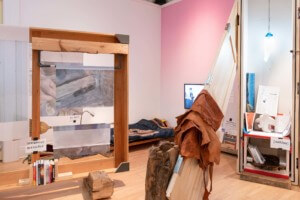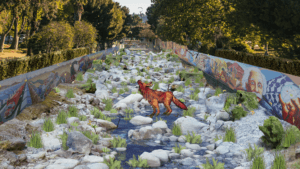The Architect’s Newspaper (AN) is live at the taping of the Greg Lynn Show at the Canadian Centre for Architecture in Montreal. Greg Lynn, curator of Archaeology of the Digital, is hosting a talk show that will serve as the public program for the opening of part 3: Complexity and Convention. “It will be all about the 90s” today, as the exhibition focuses mainly on the genesis of digital design and production. Part 3 is about seminal projects that have set standards for today’s buildings.
Live updates will come throughout the day.
Lynn starts the show off by introducing the guests, including “stand-up comedian and special effects guru Neil Denari,” and Patrik Schumacher, who is promoting his new book, “Para-Patrik Schumacher,” which is about being Patrik Schumacher.
UPDATE 2:32 EDT
Denari is the first guest is Denari, who said that not much has changed since the 90s, as the software is not that much different, just easier to use. The impetus now is on pushing the concept further. This sort of supports Lynn’s thesis for the show, which is that these are the seminal projects that still impact designers today. Denari thinks that drawing is still very important today, as 80-85 percent of the work today exists only as drawings, so much lives only in the digital world. It is very important to preserve and care for these files. Also, he said that figuration, abstraction, realism, and hyper-realism are as important today as they were in the early days of digital.
OCEAN North was a collaborative that had several factions across Europe in the 90s. Kivi Sotamaa and Johan Bettum comprised OCEAN North, whose Jyvaskyla Music and Arts Center was at the front of digital and collaborative knowledge. They were using the computer to produce forms and working processes that included many actors. Sotamaa mentioned that the aesthetic they liked happened to be suitable for this type of work—if they were minimalists, they probably would not have used it. Bettum continued, “We had some radical political ideas about architecture that challenged existing conceptions of social space, and the computer allowed us to confront those.”
Up next is Enric Ruiz Geli, whose Villa Nurbs is still under construction after more than a decade of innovating and inventing new construction methods. The new relationships between clients, builders, manufacturers, and architects took many of the middlemen out and made the design closer to the architect’s vision. “We were sending files like emails,” he explained of this radical new way of working.
UPDATE 3:04 EDT
The always provocative Francois Roche up next, and Lynn says that there are several projects under plexiglass to protect the objects, but Roche’s spiky Water Flux models are under plexiglass to protect the show from Francois. “I am not a digital masturbator,” said Roche. “I wish I were a masturbator.” The political agenda of Roche’s project extends from ecology, but today he was discussing more about how “tooling is not innocent,” as the new methods allow new meanings and relationships on the site. He said he is interested in how machines can transform a situation as an assemblage of parts.
Ulirch Konig of Chemnitz Stadium fame explained how industry and military industries are innovating with digital technology. Cars went through the digital revolution a decade before architecture because architecture is slow. Lynn disagreed. Konig says that the digital revolution changed the visual language of architecture and what is possible aesthetically, but will now change how we live and how cities work, for example with autonomous driving.
Peter Testa and Devin Weiser wrote some of the first scripts that were used in generative architectural design. They made scripts for weaving and braiding, which was different than some of the typical surface projects of the time. They told stories of how they crashed many computers and still do today, as they push the boundaries of what is possible through computation.
Nader Tehrani claims that his work, Witte Arts Center by Office dA, is the least digital in the show. “We will be the judge of that,” said Lynn. Their brickwork benefitted from the computer in the possibility of composition and construction, but not really as much in aesthetics. They pushed bricks further than they had been, such as finding all the increments in between the Flemish and standard bonds. Photoshop also came up in the conversation.
Alejandro Zaera-Polo “was just a peasant from Spain,” which made him interested in the hard work of drawing the Yokohama Port Terminal in AutoCAD himself. Rafael Moneo once told him it was interesting in the worst way possible. Japanese architects, however responded much differently, as they were surprised at the efficiency with which it was produced.
Wolf Prix is up next, and makes an illusion to his inflatables in the 1960s as a proto-cloud. This connection between pneumatic structures and data comes from his idea that he doesn’t care about the computer, but about new ways of making spaces that haven’t been seen before. The BMW Welt project and its film are in the show. Prix explained how BMW wanted a huge model to demonstrate how the building would work and look. They couldn’t do a 1:1 model, but instead made a very intricate movie that involved mixing physical models and digital surfaces, and a film crew of 30 with catering and everything. The final cost was 800,000 euros, but it convinced BMW to make the building, mostly because they saw a scale car, and it let them know it was a big building.
Patrik Schumacher is here to talk about the Phaeno Science Center, a seminal work by Zaha Hadid Architects. MAXXI and the CAC in Cincinnati were also completed around this time. The delivery of the building required sophisticated millwork to produce the formwork for curved waffle-slabs. Some of these projects had the benefit of German engineering, but projects in places like Azerbaijan and China, where construction technology was not as sophisticated. The early work in Europe was good practice for these more complicated contexts.
He explained that the modernist movement came about in the 20s, but only transformed the world in the 1960s, after an interruption from WW2. Likewise, he said, the digital came about in the 90s, and has been interrupted, but it is time now for the digital and parametric to transfrom the world: not as art, but as a complete reworking of the way we make society.










